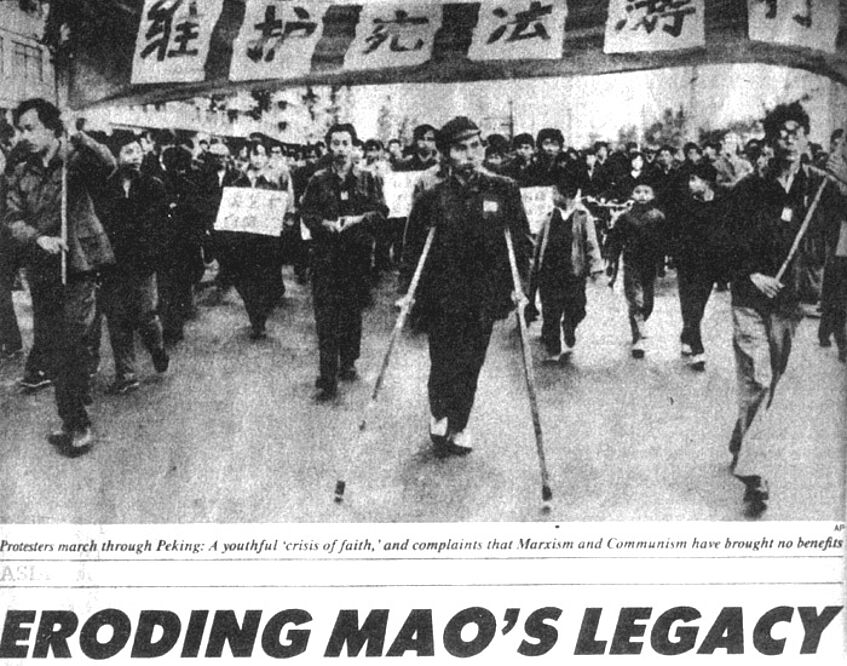
"Newsweek" (October 15, 1979 issue) reports on the demonstration by artists and political activists on October 1, 1979 in Beijing
Farewell to Socialist Realism
Many independent writers, artists and movie makers, often from Shanghai, and representing many different artistic tendencies, supported in one way or the other the Maoist revolutionary movement during the 1930s and 1940s.
After the founding of the People's Republic in 1949 though, the limits of what was authorized and desirable in the fields of literature and arts, had clearly narrowed. "Socialist Realism", not so different from the norms and aesthetics of the Stalinist Soviet Union, became the guiding principle for all artistic expression in China, maybe complemented to some extent by national Chinese traditions.
Relatively new Western trends such as expressionism or impressionism, aestheticism, existentialism, abstract art or surrealism, were certainly not included in the new official codex for art in China.
As early as 1942, in his famous theses formulated in Yan'an, Mao Zedong stipulated that art and literature under socialist conditions had to serve exclusively "the proletariat" and the political goals of the revolution. During the Cultural Revolution (1966-76) this principle was further accentuated by Mao's spouse Jiang Qing (江青), a former movie actress who had held own seat in the Political Bureau. She decreed a small number of "model pieces" that had to be propagated all over the country. At the same time, many creative artist were persecuted, their works forbidden and sometimes (books, paintings, sculptures, ...) even physically destroyed.
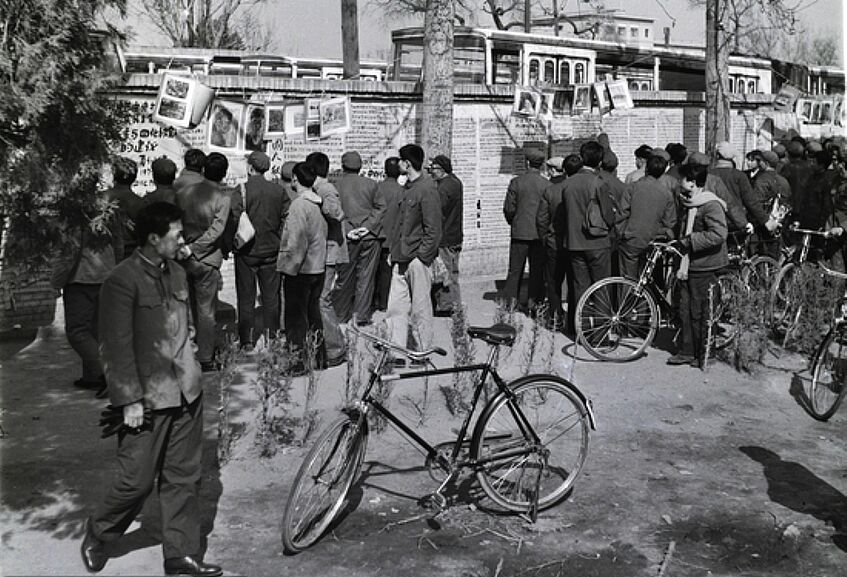
Sichuan artist Xue Mingde showing his paintings at the Beijing Democracy Wall (1979)
A non-conformist behavior was only possible in the private sphere. Young artists or authors painted and wrote in the underground for themselves or for a few trustworthy friends. Later in the 70s, creative activities in public were only possible within the framework of academies and official writers' and artists' associations.
Only in the second half of the 1970s several informal groups got together to test the ground for new ways and styles, like the "No Name Painting Association" (无名画会), who were able to organize an exhibition in the Beijing Beihai Park in July 1979 showing works of art that clearly went beyond Socialist Realism. Also at the Beijing Democracy Wall, several independent artists showed their creations in informal open sky exhibitions.
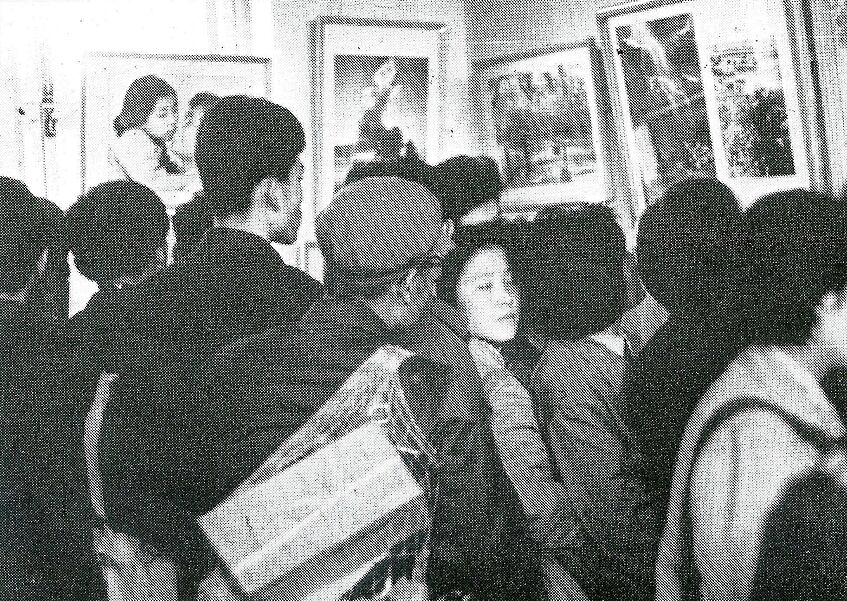
Exhibition "Nature - Society - Man" by the "April Photography Association" (Beijing, 1979)
A still more radical departure from the official line could be found among the rebellious painters and poets who organized themselves in the "Stars Artists' Association" (Xingxing Huahui 星星画会) and around the independent journal "Today" (Jintian 今天), both closely related to the Democracy Movement. Another like-minded group was the "April Photography Association" (四月影会) who had its origins in the April protests on Tiananmen Square in 1976. In any case, in the Chinese tradition of a holistic concept of art, the boundaries between painters, poets, photographic artists, sculptors and graphic designers were fluid, and most of them excelled in more than one field.
The "Stars" Group (Xingxing 星星)
In English they are usually called "The Stars", but their Chinese name is deliberately ambiguous, and actually it has a different origin: It refers to Mao's famous saying from 1930 "A single spark can start a prairie fire" (星星之火可以燎原). A correct translation would therefore be "The Sparks", but "The Stars" sounds classier of course, so everyone now calls them in English "The Stars".
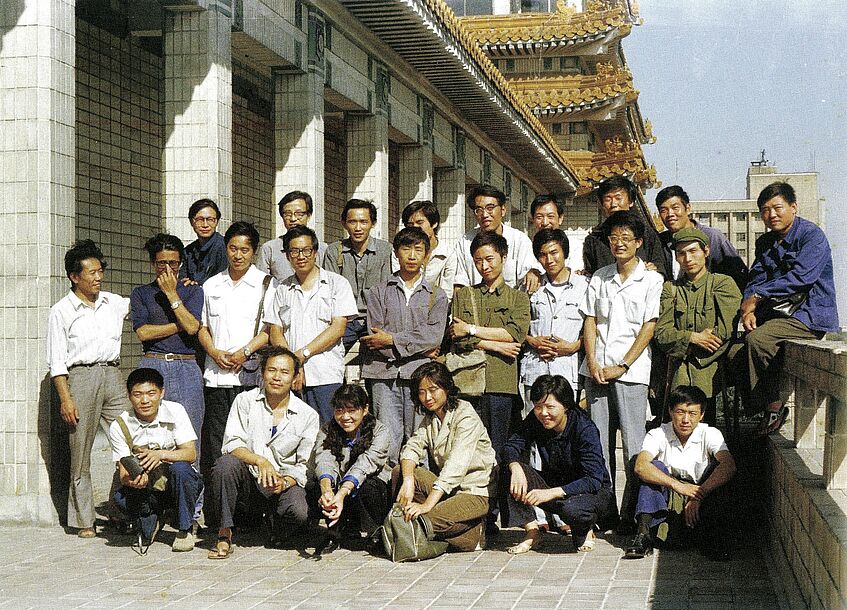
Members of the "Stars" group on the Roof of the Beijing Fine Arts Gallery (August 1980)
The group is formed in mid-1979 by several friends. Huang Rui (黄锐), Ma Desheng (马德升), Qu Leilei (曲磊磊), Yang Yiping (杨益平), Li Yongcun (李永存, artist's Name Bo Yun 薄云) and Zhong Acheng (钟阿城) are all self-tought artists, and they also participate in the founding of the "Today" magazine. Another one is the sculptor Wang Keping (王克平) who likes to carve suggestive political and erotic objects from strangely shaped pieces of wood.
Soon after a few younger artist join the group: the painter and lyric poet Yan Li (严力) and his then-girlfriend Li Shuang (李爽) who is also painting; the army artist Mao Lizi (毛栗子), and the at that time completely unknown Ai Weiwei (艾未未), the son of Ai Qing (艾青), a famous revolutionary poet and high-ranking cultural official who had suffered persecution after the Anti-Rightist Campaign of 1957.
The "Stars Artists' Association" gave itself a charter and persued the goal to organize a public group exhibition.
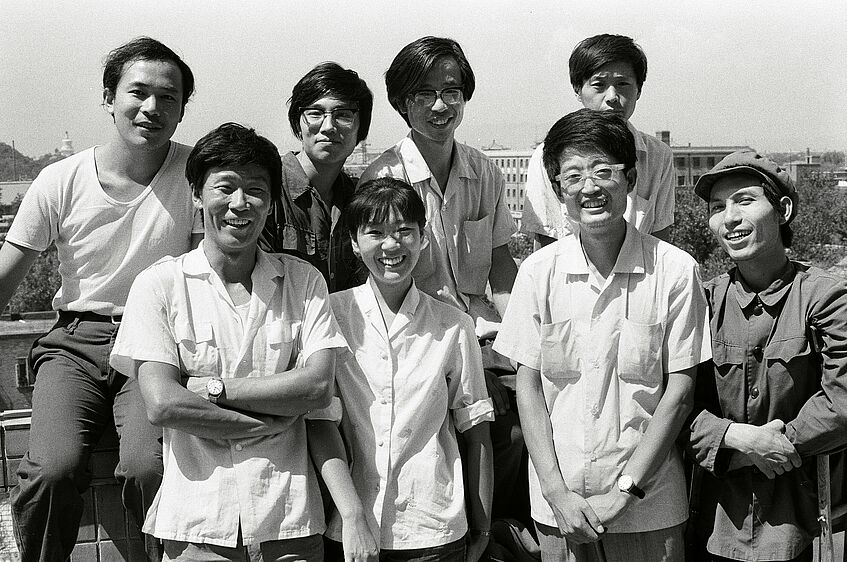
Leading members of the "Stars" (August 1980). From left to right: Wang Keping, Qu Leilei, Yan Li, Li Shuang, Huang Rui, Zhong Acheng, Chen Yansheng, Ma Desheng
The Poets of "Today" (Jintian 今天)
It has been noted before, the traditional Chinese concept of art does not strictly seperate painting, calligraphy and poetry, and many of the young autodidacts of the avant-garde groups practice several of these forms of artistic expression.
The painters and sculptors of "The Stars" are therefore closely interlocked with the editorial team of "Today". The painter Huang Rui is responsible for the layout, a kind of "art director" as we would call him today, and he also designed the distinctive blue cover page of the journal. Qu Leilei and Ma Desheng regularly contribute illustrations and - at the beginning even small original woodblock prints that were pasted directly into each copy. Lyricist Bei Dao (北岛, originally Zhao Zhenkai 赵振开) and prose author (and painter) Mang Ke (芒克) are co-founders and Editors-in-chief of "Today".
Apart from the "misty" or "obscure poetry" (朦胧诗 - deliberately polysemous lyrics whose subtle symbolics reflect very individual sentiments that may be interpreted in different ways), the texts published in "Today" often relate to emotions and experiences from the Cultural Revolution. It is the literature af a "lost generation", often born around 1950, who was deprived of the chances of good education and a happy adolescence. Most of the authors of the magazine belonged to this age group. Besides Bei Dao, several other authors of "Today" have later become well-known representatives of contemporary Chinese lyrics, such as Shu Ting (舒婷), Yang Lian (杨炼), Gu Cheng (顾城), Duo Duo (多多), or Jiang He (江河).
Just like the "Stars" artists, the authors of "Today" also fiercly debate whether they should confine themselves to creative and cultural themes, or deliberately become part of the political Democracy Movement. Opinions are devided in the groups, but persuing "pure arts" becomes difficult at a time of deep social upheavals and political developments that eventually also bear on their own artistic and personal lives.
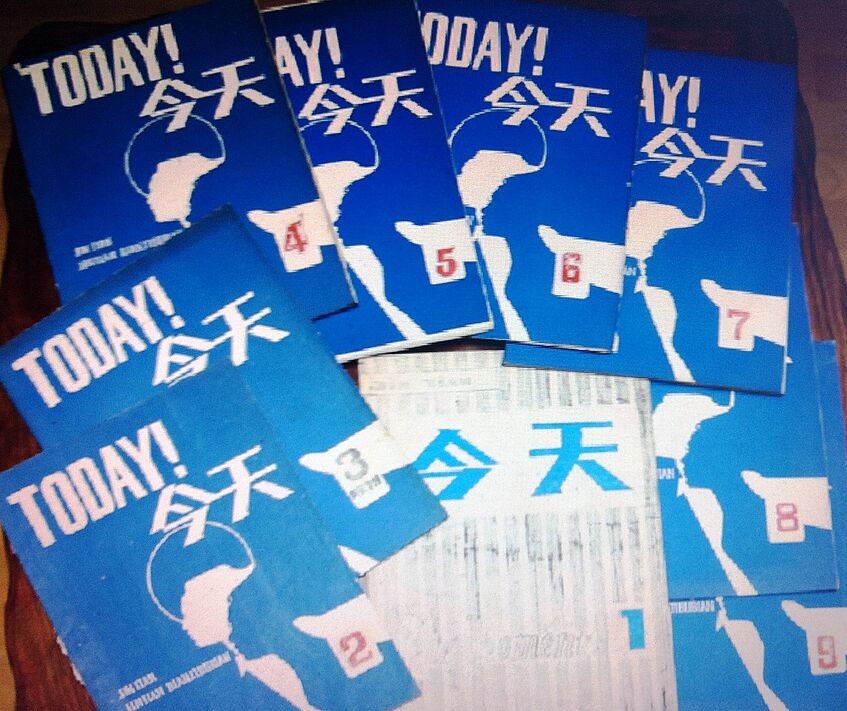
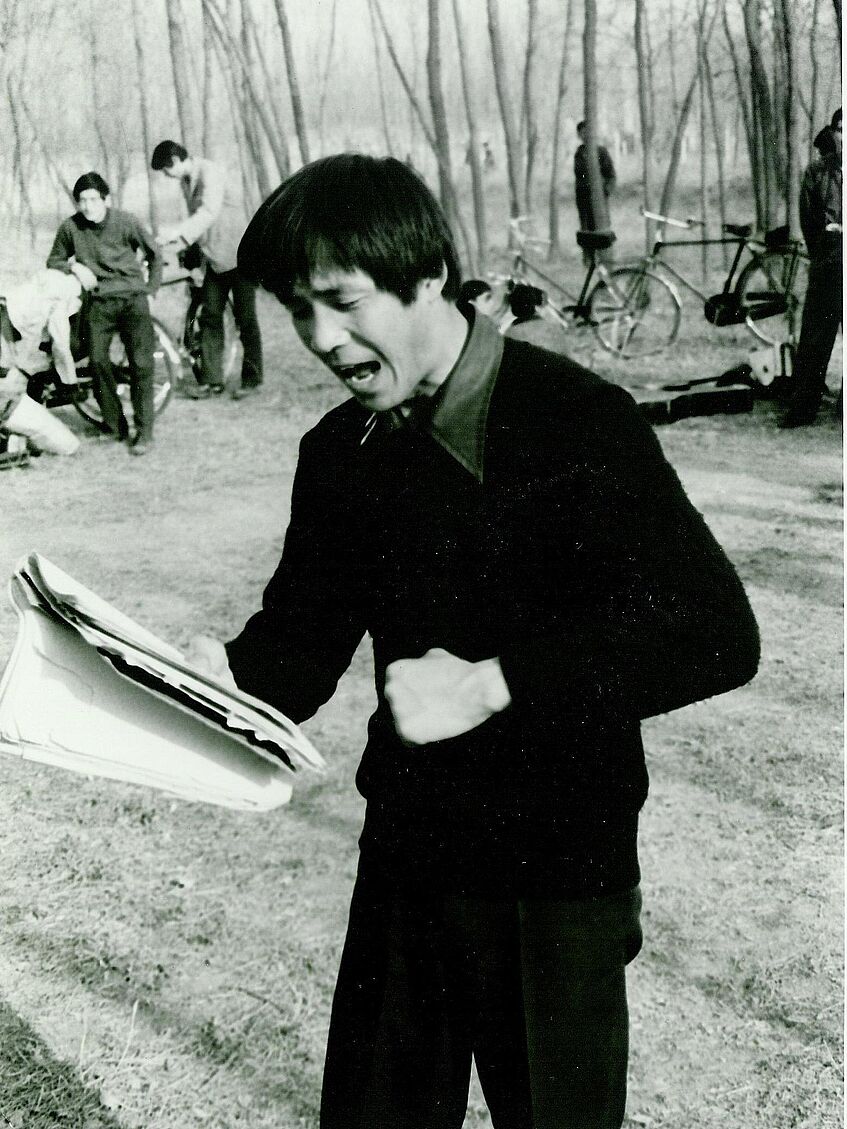
Recital of poems by Hei Dachun (黑大春) at the "old summer palace" (Yuanmingyuan 圆明园) on April 5, 1981 (5th anniversary of the Tiananmen protests of 1976)
The Demonstration of October 1, 1979
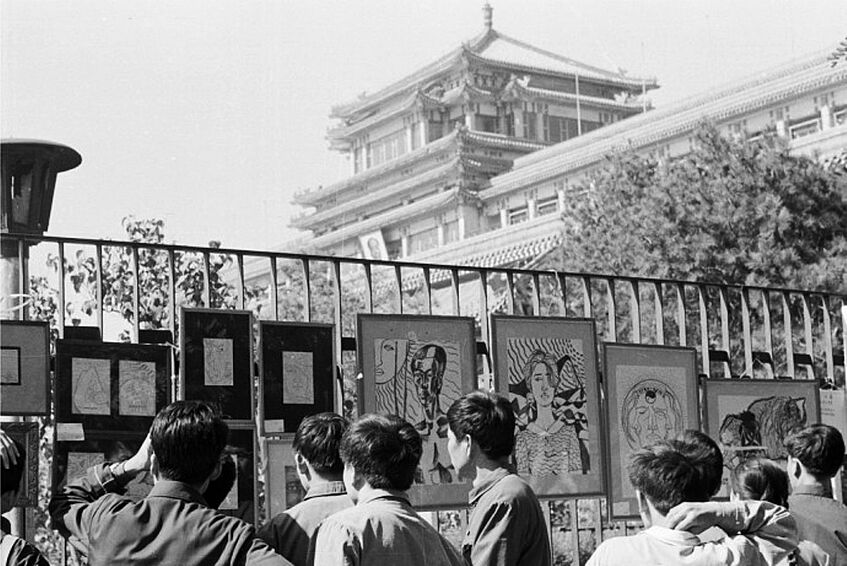
The "Stars" artists have attached their works to the outer fence of the Beijing Fine Arts Gallery (September 27, 1979)
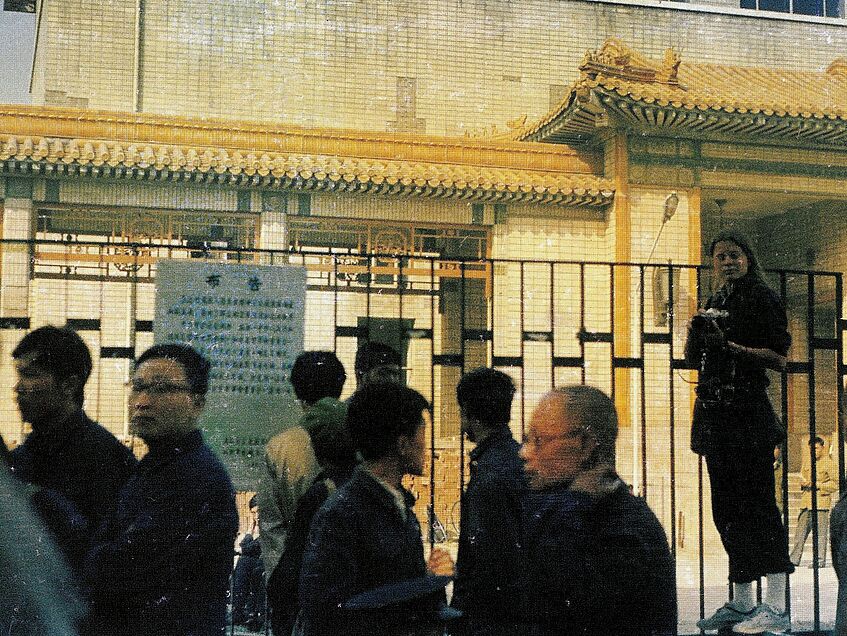
A police decree orders the closure of the exhibition after a few hours
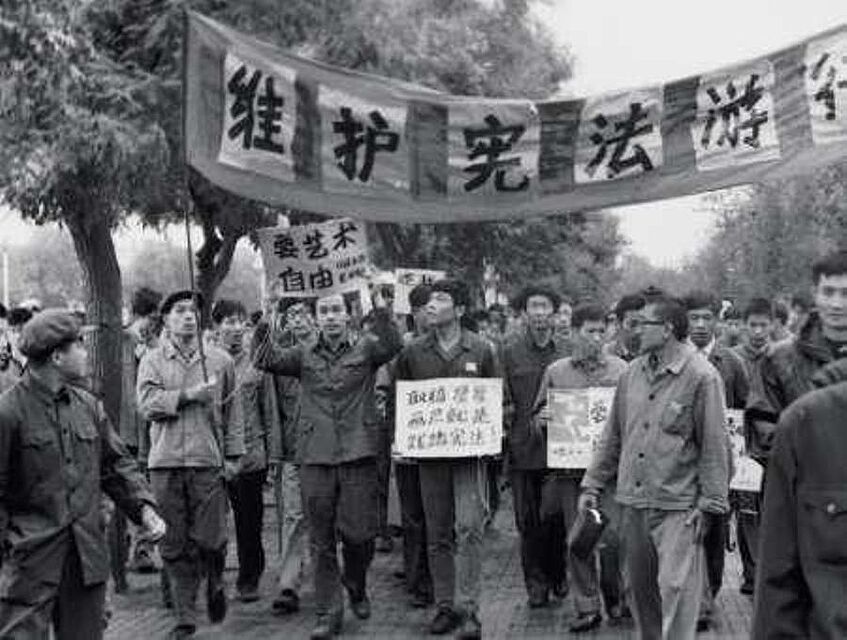
"Demonstration to safeguard the constitution" marching through the center of Beijing
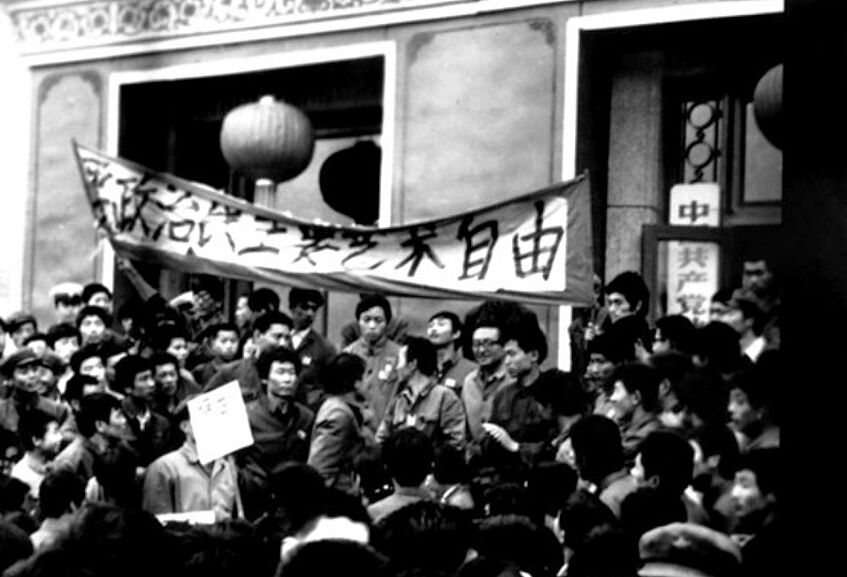
In front of the seat of the Beijing municipal administration ("Revolutionary Committee") and the Communist Party offices
The Demonstration of October 1, 1979
It is in May 1979 that the members of the "Stars" group meet in a private Apartment in Beijing to discuss the idea of organizing an avant-garde art Exhibition. Huang Rui and Ma Desheng are sent to meet Liu Xun (刘迅), the chairman of the official Artists' Association in Beijing. Liu himself was branded a "rightst" in the 60s and has spent ten years in prison. When he come to Huang's flat to view some of the works that have been hastily prepared for a potential exhibition, he is at first impressed and reveals sympathy for the project. But shortly after he lets the "Stars" artists know that the Beijing "Gallery of Fine Arts" (today's "National Gallery") were fully booked all the way through 1980, therefore an exhibition would not be possible, not in a different place either.
This message means a clear "no", but the avant-garde artists sense the dynamics of change (and the are afraid that a year later circumstances might be less favorable again). They decide therefore to display their works at first in an open air Exposition to gain public attention, and they chose space outside the Fine Arts Gallery (Meishuguan 美术馆) where they want to mount their paintings and sculptures an the metal fence that encloses the grounds.
They are aware of the sensitivity of their planned action and do not want to alert the authorities too early, so they only post their announcement a day before the planned opening. They have borrowed a small truck, and during the night of September 26 they transport their several dozen works to the site and attach them with strings and hooks on the outside of the fence. Their friends of the "April Photographic Society" are also present to document the happening.
The next morning thousands of onlookers are attracted by the open-air show near a busy intersection, but there are also many who have been informed and invited in advance, including Jiang Feng (江丰), the influential Chairman of the All-China Artists Association, and a number of journalists of international media.
But in the end, police shows up as well. They formally interdict the exhibition, and ask the organizers to remove their works. After some negotiations the paintings are not taken away, but "temporarily" stored in a gallery depot, while a few particularly "sensitive" art works are quickly removed to a safe place with friends to avoid the risk of confiscation.
Further negotiations with authorities remain without result, despite an attempt by the Artist Association to mediate. After Long debates the artist decide to join forces with representatives of the political civil rights groups who have offered their support. Artist and editors of various independent journals meet to prepare a protest march on October 1 (China's National Day!) that should lead from the Democracy Wall through Beijing's city center to the seat of the municipal party committee further to the east.
Several hundred activists eventually show up for this historic rally, led by Xu Wenli and Lü Pu (吕朴) of the "April 5th Forum", Mang Ke und Bei Dao ("Today"), and the artists Huang Rui, Ma Desheng and Wang Keping who all march in the first row. On their banners they demand "political democracy" and "artistic freedom", respect for the Chinese constitution (that guaranties such rights), and of course permission to organize the independent art exhibition.
They are well aware of the tense situation, and as some later admit, they expect a dispersal of the demonstration by force. But to their own surprise, police posted along the main Chang'an Avenue only asks them to change their planned route and not to pass through Tiananmen Square but on a parallel street further south. When they reach the building of the Party Committee near the Beijing Hotel, brief speeches are made, and despite the national holiday, a party representative eventually receives some delegates, listens to their demands and promises to pass them on to his superiors.
The "Stars" Exhibitions
To the surprise of many participants , the protest on October 1 is successful, which is possible because part of artists from the official associations are giving support to the young avant-garde painters.
On November 23 they are eventually allowed to open their first public show. The Beijing Artist Association has provided their Huafangzhai Pavillon (画舫斋) in Beihai Park to the "Stars" group, and during two weeks the works of 23 artists are displayed: oil paintings, inks, wood-block prints and a few sculptures, under the motto "To explore the world with one's own eyes, and to participate in it with brush and carver's knife" (用自己的眼睛认识世界,用自己的画笔与雕刀参与世界).
In March 1980, the well-known art critic Li Xianting (栗宪庭) publishes a first review of the "Stars" group and their exhibition in the official "Fine Arts" (Meishu 美术) magazine. It is a very positive summary, accompanied by photos of some of the works. The spell is broken, it seems.
In August 1980 the group is finally allowed to show their art also in the central "Fine Arts Gallery", the place that has remained off-limits to them the year before.
As much as the first permitted "Stars" exhibition in November 1979 was rather quickly organized and on a relatively small scale (with very few photos and documents remaining), the second exhibition in 1980 becomes a big success. Even the party organ "People's Daily" (Renmin Ribao 人民日报) prints an announcement, 140.000 visitors eventually show up at the venue during the two weeks of showing, eager to see works of a hitherto unknown group of young self-tought artists - a kind of art that has never been shown before since the founding of the People's Republic of China.
The motto of the second Exhibition reads: "We are no children any more. We want to use a new and more mature language to start a dialogue with the world." (我们不再是孩子了。我们要用新的,更加成熟的语言和世界对话。)
The exposed works of art are of very mixed significance: Some artists try to imitate Western styles, borrowing from expressionism, fauvism or minimalism, others want to combine Western and Eastern heritage, a few even dare artistic forms that have been undesirable and prohibited for decades, such as abstract and surrealist painting, or the female nude that has for a long time been frowned upon.
There is also a small number of artists who dare open political provocation. The most outspoken of all are the wooden sculptures of Wang Keping. His "Idol" (偶像) - combining facial features of Mao and Buddha - becomes the icon of the "Stars" exhibition.
Although in the years to come there would be many more controversies between politics and arts, although many of the young artists will leave China (and some will remain abroad), the "Stars" mark a first opening up of the arts that continues and is still felt in China today, surpassing by far the readiness for similar liberalization and reform efforts in the political sphere.
(More photos from the second "Stars" Exhibition in August 1980 you may view here.)

The first authorized "Stars" exhibition in November 1979 (with paintings by Huang Rui)
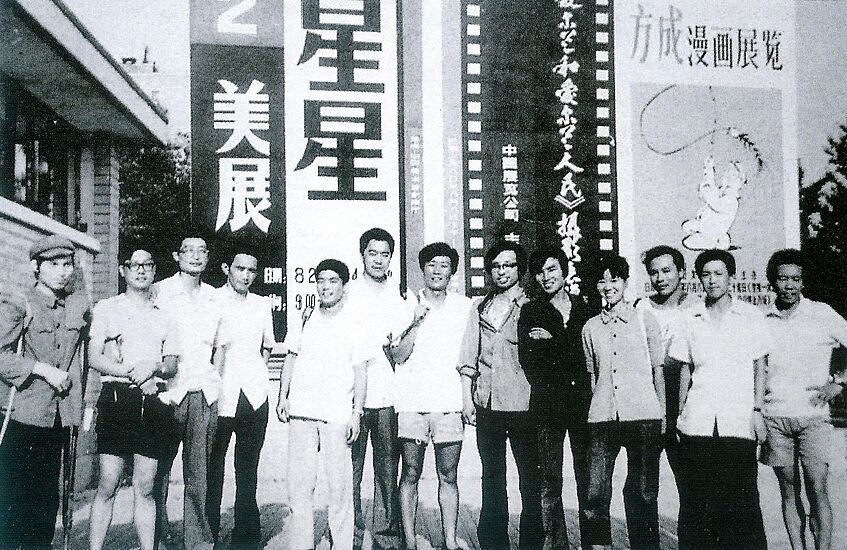
Visitors of the second "Stars" exhibition in August 1980 in front of the Beijing Fine Arts Gallery
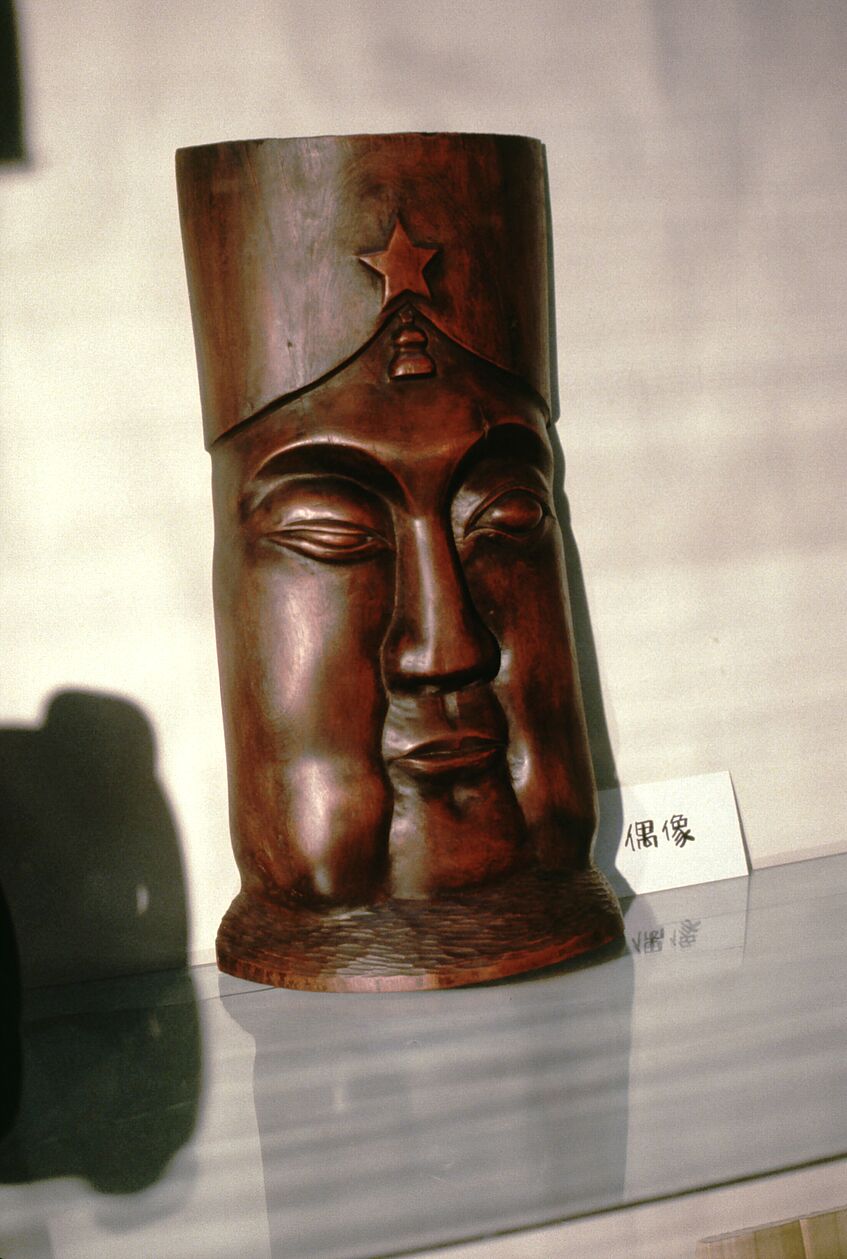
Wang Keping's famous "Idol" on display in the second "Stars" exhibition
